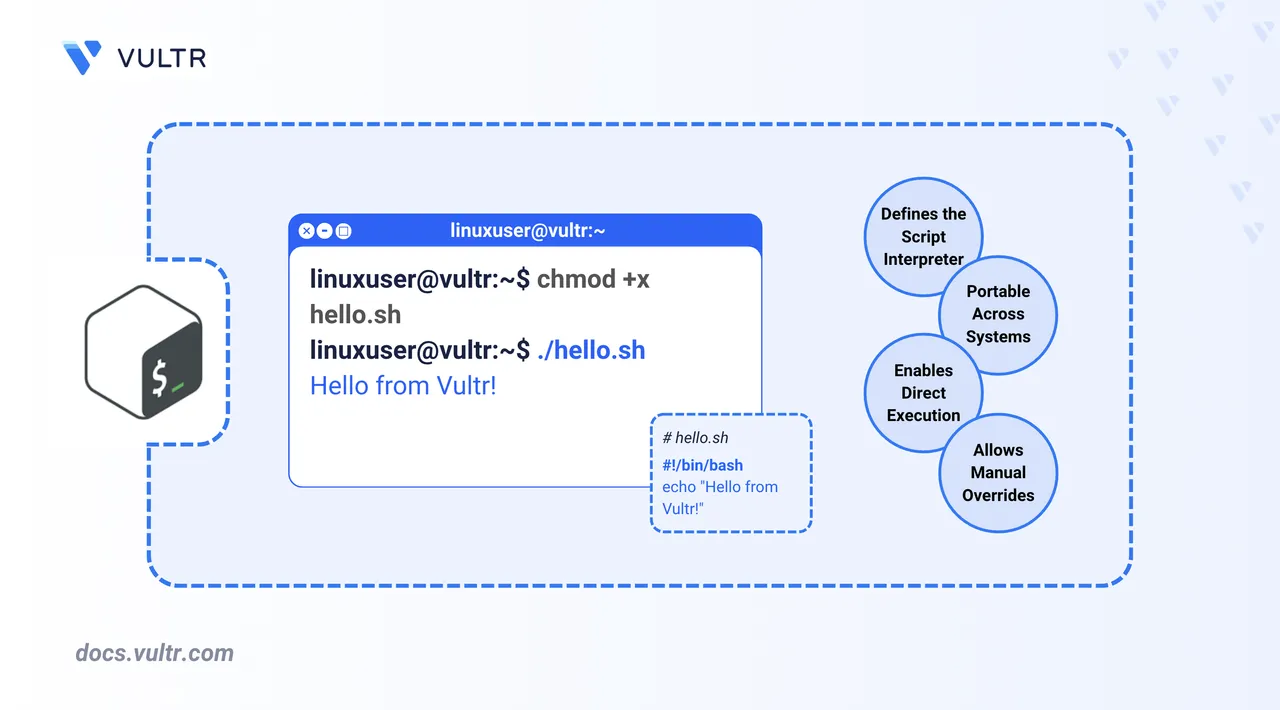
In Bash and other UNIX-like operating systems, a shebang (#!) is the character sequence placed at the beginning of a script. This line tells the system which interpreter to use when executing the script directly from the command line. By specifying the interpreter (e.g., Bash, Python, or Perl), the shebang ensures your script runs consistently across different environments, making it both portable and predictable.
This article explains how to use a shebang in Bash scripts, override it when necessary, and ensure your scripts run seamlessly across different systems.
Shebang Interpreter Directive
The shebang interpreter directive takes the form:
#!/path/to/interpreter [arguments]It must appear as the first line of the script. The interpreter is usually a full path like /bin/bash or an indirect reference using env, like /usr/bin/env bash.
Examples:
#!/bin/bash: Runs the script using the Bash shell located at/bin/bash.#!/usr/bin/env perl: Usesenvto find and executeperlfrom your$PATH.#!/usr/bin/python: This executes the script using thepythonbinary.
If a shebang is not specified, and the user running the Bash script is using a different shell, the script will be parsed by that shell's default interpreter. For example, bash is the default interpreter for bash shell, and sh is the default for zsh. To ensure your script is always interpreted with Bash, you need to specify the executable path using a shebang.
You can define the interpreter using two primary shebang methods:
Using the absolute path to the Bash binary:
bash#!/bin/bashThis tells the shell to use the Bash executable located at
/bin/bashto run the script.Using the env:
bash#!/usr/bin/env bashThis is the preferred way to write portable scripts because it avoids hardcoding the interpreter path. It searches for the
bashexecutable in the user's$PATHand uses the first match found.To enable debugging in your script, use theNoteset -xcommand after the shebang line. This works regardless of whether you're using a direct interpreter or a portable pattern.
Use Shebang in Bash Scripts
This section demonstrates how to use a shebang to define the interpreter for a Bash script.
Create a new file named
hello.shusing a text editor.console$ nano hello.sh
Add the following content to the file:
bash#!/bin/bash echo "Hello from Vultr!"
Save and close the file.
Make the script executable.
console$ chmod +x hello.sh
This command adds execute permissions to the file, allowing the system to run it.
Execute the script.
console$ ./hello.shOutput:
Hello from Vultr!The shebang (
#!) ensures the script runs with the Bash interpreter, even though you didn’t explicitly invokebash hello.sh.
Override the Shebang
While the shebang provides the default interpreter, you can explicitly override it by calling the interpreter directly when executing the script. This is helpful for testing compatibility or forcing execution under a different shell.
For example, even if
hello.shhas#!/bin/bashas its shebang, you can execute it with theshinterpreter:console$ sh hello.sh
In this case,
shprocesses the script, ignoring the shebang. This is useful when testing how a script behaves under different shells.To test the script with a specific version of Bash, such as one installed in a non-standard location (
/usr/local/bin/bash4.4), run.console$ /usr/local/bin/bash4.4 hello.sh
This command bypasses the shebang and forces execution with the specified Bash version useful when validating version specific features or behavior.
Conclusion
In this article, you learned how to use a shebang (#!) to create executable and portable Bash scripts. You now know how to specify the correct interpreter, make a script executable, and override the shebang for testing purposes. Understanding the shebang is a fundamental skill for writing effective scripts for server administration and automation.